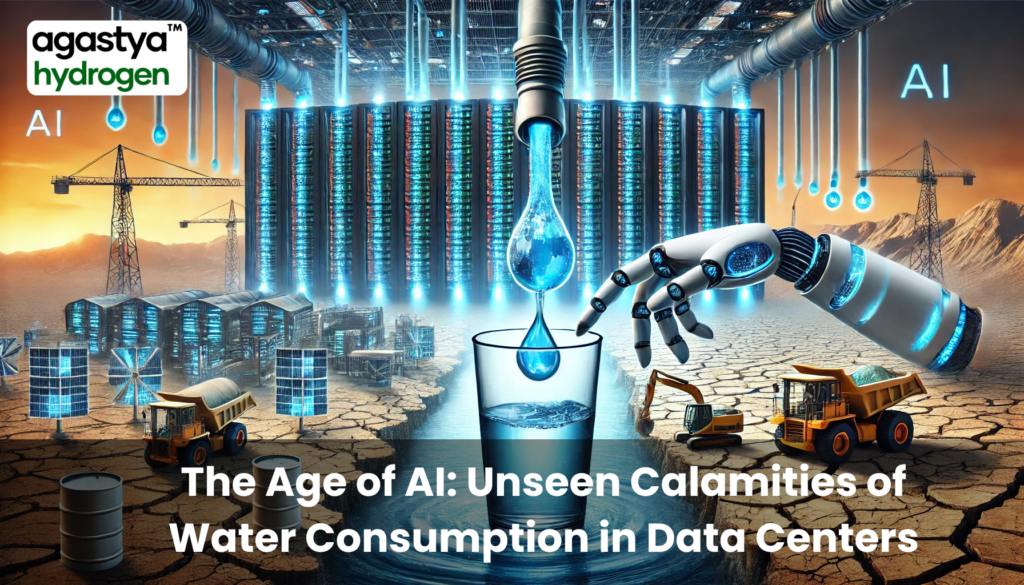Dear Impact Makers, let’s understand the blind spot of the AI start-up revolution with deep driving into Data Centers & AI: The Unseen Calamities of Water Consumption.
Artificial Intelligence (AI) is revolutionizing industries and driving unprecedented advancements across the globe. From healthcare to transportation, AI is transforming our world. However, this technological boom comes with a hidden, often overlooked cost—massive water consumption. As AI models become increasingly complex and powerful, the servers that power them require cooling, and data centers—the backbone of AI—are consuming water at an alarming rate.
The Thirst for Water
Data centers play a critical role in AI, housing thousands of servers that process and store massive amounts of data. These servers generate intense heat, which requires efficient cooling systems to maintain performance. Traditionally, water-based cooling systems are used in data centers because they are highly effective at regulating temperatures. However, this method has a significant environmental impact—excessive water consumption.
For example, a two-week training session for OpenAI’s GPT-3 at Microsoft’s data center in the U.S. consumed an astonishing 700,000 liters of freshwater. To put that into perspective, this is equivalent to the water needed to manufacture approximately 370 BMW cars or 320 Tesla electric vehicles. As AI models grow more sophisticated and widespread, the water demand from data centers is set to rise exponentially.
Ground Report: Data Centers and Water Scarcity
In recent years, the impact of data centers on local water supplies has become increasingly apparent. In Iowa, USA, data centers are consuming up to 20% of the water used by some cities. This is especially concerning given that Iowa is in the midst of one of its worst droughts in decades. According to the National Oceanic and Atmospheric Administration (NOAA), 85% of Iowa was in drought conditions by mid-March.
The issue isn’t isolated to Iowa. In areas with limited water resources, data centers are exacerbating water scarcity problems, sometimes causing local conflicts over water rights. In Altoona, Iowa, the high water consumption of data centers has already strained local water supplies, raising concerns among residents and environmental groups about the long-term sustainability of such practices.
The Environmental Impact
The environmental consequences of data centers go far beyond water consumption. The energy required to power these facilities is massive, and much of this energy still comes from non-renewable sources, contributing to carbon emissions and climate change. AI models like ChatGPT require vast computational power, which in turn leads to high energy consumption, placing further pressure on power grids and contributing to increased CO2 emissions.
Additionally, the water used for cooling is often drawn from local sources, which can disrupt ecosystems and impact biodiversity. The use of potable water—water that is safe for human consumption—for cooling purposes is particularly troubling, as it competes with other essential uses like drinking water and agriculture.
Investing in Green Hydrogen
A promising solution to the environmental challenges posed by data centers is the use of green hydrogen. Green hydrogen is produced using renewable energy sources like wind or solar power, and it emits no greenhouse gases during production or use. By transitioning to green hydrogen, data centers could significantly reduce both their carbon footprint and their water consumption.
One example of this shift is Microsoft’s pilot project in Dublin, Ireland, where the company is trialing hydrogen fuel cells to power its data center. The goal of this project is to demonstrate the feasibility of using hydrogen to power data centers and potentially transform the way these digital infrastructures are fueled. The trial involves deploying hydrogen fuel cells that will provide up to 250kW of power to a data center’s control and administration building over a period of eight weeks.
The Influence of Green Hydrogen
- Zero Emissions: Hydrogen fuel cells produce electricity with zero emissions, emitting only water vapor as a byproduct. This could replace fossil fuel-based power generation, drastically reducing harmful pollutants like NOx, SO2, and PM.
- Reduced Water Consumption: Unlike traditional water-based cooling systems, hydrogen fuel cells do not require water for cooling. This could alleviate the pressure on local water supplies and lessen the environmental impact of data centers.
- Energy Independence: Hydrogen can be produced on-site using renewable energy sources, which would reduce dependency on external power grids and enhance energy security. This is particularly useful for data centers in remote or water-scarce regions.
- Scalability and Flexibility: Hydrogen fuel cell systems are modular, meaning they can be scaled up or down depending on the size and energy requirements of the data center. This flexibility makes hydrogen fuel cells suitable for both small and large facilities.
- Industry Influence: As Microsoft leads the way, their adoption of green hydrogen could set an example for other tech companies, encouraging industry-wide investments in sustainable energy solutions. This could catalyze broader adoption of green hydrogen in the data center sector, driving positive change across the industry.
Expert Opinions
Industry experts are increasingly calling for sustainable solutions in data center operations. Paul Deane, a senior lecturer in clean energy futures at University College Cork, points out the “ferocious appetite” that AI has for both energy and water. He emphasizes the need for integrating renewable energy sources and innovative cooling technologies to address these environmental challenges.
Palki Sharma, a journalist, also investigated the growing issue of water consumption by data centers. She highlighted how AI-driven demand is putting increasing strain on local water supplies, urging greater transparency and regulatory measures to manage water usage effectively.
Conclusion
AI’s transformative power comes with a significant cost—massive water consumption. Data centers, which power AI models, are consuming unprecedented amounts of water, stressing local water supplies and ecosystems. However, there is hope. Agastya Hydrogen- AEM Electrolysers and HRS presents a sustainable alternative to traditional cooling and energy systems, offering zero emissions, and reduced water consumption in data centers.
By investing in green hydrogen, companies like Microsoft are leading the charge in developing sustainable solutions to power the next generation of AI and data infrastructure. For a future where AI can continue to thrive without exhausting our most precious resource—water—the tech industry must embrace green hydrogen and sustainable practices. The time to act is now before the unseen calamities of water consumption become irreversible.


